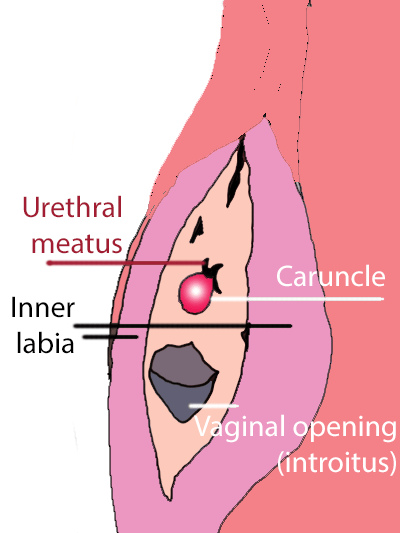Urethral caruncles are lesions on the outer portion of the urethra (the urethral meatus, the distal urethral mucosa). These lesions are most common postmenopause, less common premenopausal, and are sometimes found in children (urethral polyps). 1

Urethral caruncles are often benign, but they may look similar to urethral cancers, resemble a urethral prolapse, periurethral gland/duct (Skene’s gland, female prostate) cysts or abscesses, or urethral diverticulum. 2
Symptoms of urethral caruncles
- Pain and sometimes bleeding3
- Visible lesion – typically quite small but can be up to 1cm
- Pain or burning on urination as the acidic urine makes contact with the lesion
- The lesion are pink or red, and sometimes black or purple
- The fleshy lesion doesn’t usually go around the whole circle of the urethral meatus (like in urethral prolapse), instead sits only on one portion
- Far more common in elders than any other group
- Most often asymptomatic, found during routine examinations
Urethral caruncles are not typically a cause of urinary problems. If there are other urinary symptoms, they may be treated separately.
Diagnosis of urethral caruncles
The most common cause of urethral caruncles is the atrophy of the mucosa due to low oestrogen (linked with genitourinary symptoms of menopause (GSM, formerly known as atrophic vaginitis).
Oestrogen keeps skin supple and lush, so when oestrogen drops, skin can start to see unusual damage, easy tearing and dryness.
A curuncle may be continually irritated and this irritation keeps the problem around longer, and adds to the symptom burden (bleeding, pain).
Caruncles due to low oestrogen are reasonably easily fixed with topical oestrogen applications or increasing phyto-oestrogen-rich foods.
Low oestrogen conditions, however, aren’t the only reason for urethral caruncles. Other causes are far rarer.
Cases have been reported whereby urethral melanoma, tuberculosis, intestinal ectopia, lymphoma and urethral leiomyoma had a very similar symptom picture. Cancer has been found in only a couple of caruncles.4 Pregnancy may make caruncles worse.
Biopsy is usually unnecessary but may be recommended if the lesion is suspected of being dangerous. Cystoscopy may be performed to check out the inside of the bladder.
Urethral caruncles have been occasionally linked to autoimmune conditions but this requires further study. 5
Treatment of urethral caruncles
The point of treatment is to reduce inflammation and the cause of the issue where it is obvious, for example, where there is low oestrogen.
Avoid use of soaps, perfumes, douches, laundry detergent of questionable ingredients, artificial fabrics, non-organic sanitary products, etc. Err on the side of caution to resolve the problem. Be diligent – the tissue is very delicate.
Treatment recommendations may include:
- Warm sitz baths
- Vaginal oestrogen replacement
- Anti-inflammatory drugs
- Surgery, when the lesions are large, the diagnosis is uncertain, treatment has failed or the lesions look unusual6
Outcomes after treatment are most often very good.
References
- 1.Verma V, Pradhan A. Management of urethral caruncle – A systematic review of the current literature. European Journal of Obstetrics & Gynecology and Reproductive Biology. Published online May 2020:5-8. doi:10.1016/j.ejogrb.2020.03.001
- 2.Babty M, Slaoui A, Mamad A, et al. Urethral Caruncle: An Entity Not to Be Ignored. OALib. Published online 2023:1-6. doi:10.4236/oalib.1109583
- 3.Sonoda K, Kato R, Kojima H, Tokuda Y. Urinary tract bleeding from a urethral caruncle mimicking genital tract bleeding. BMJ Case Rep. Published online February 2019:e225540. doi:10.1136/bcr-2018-225540
- 4.Safadi A, Schwalb S, Ben-Shachar I, Katz R. Primary malignant urethral melanoma resembling a urethral caruncle. Urology Case Reports. Published online November 2017:28-29. doi:10.1016/j.eucr.2017.08.004
- 5.Williamson SR, Scarpelli M, Lopez-Beltran A, Montironi R, Conces MR, Cheng L. Urethral caruncle: a lesion related to IgG4-associated sclerosing disease? J Clin Pathol. Published online November 30, 2012:559-562. doi:10.1136/jclinpath-2012-201218
- 6.Balai M, Gupta L, Kumari A. Urethral caruncle in a perimenopausal female: Dramatic response to topical estrogen cream. Indian J Urol. Published online 2018:308. doi:10.4103/iju.iju_200_18







